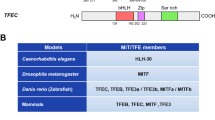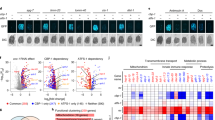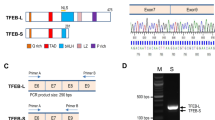Abstract
Hematological changes induced by various stress stimuli are accompanied by replacement of the primary acetylcholinesterase (AChE) 3′ splice variant acetylcholinesterase-S (AChE-S) with the myelopoietic acetylcholinesterase-R (AChE-R) variant. To search for putative acetylcholinesterase-S interactions with hematopoietic pathways, we employed a yeast two-hybrid screen. The transcriptional co-repressor C-terminal binding protein (CtBP) was identified as a protein partner of the AChE-S C terminus. In erythroleukemic K562 cells, AChE-S displayed nuclear colocalization and physical interaction with CtBP. Furthermore, co-transfected AChE-S reduced the co-repressive effect of CtBP over the hematopoietic transcription factor, Ikaros. In transgenic mice, overexpressed human (h) AChE-S mRNA induced selective bone marrow upregulation of Ikaros while suppressing FOG, another transcriptional partner of CtBP. Transgenic bone marrow cells showed a correspondingly elevated potential for producing progenitor colonies, compared with controls, while peripheral blood showed increased erythrocyte counts as opposed to reduced platelets, granulocytes and T lymphocytes. AChE's 3′ alternative splicing, and the corresponding changes in AChE-S/CtBP interactions, thus emerge as being actively involved in controlling hematopoiesis and the potential for modulating immune functions, supporting reports on malfunctioning immune reactions under impaired splice site selection.
This is a preview of subscription content, access via your institution
Access options
Subscribe to this journal
Receive 12 print issues and online access
$259.00 per year
only $21.58 per issue
Buy this article
- Purchase on Springer Link
- Instant access to full article PDF
Prices may be subject to local taxes which are calculated during checkout







Similar content being viewed by others
Accession codes
References
Bartholdy B, Matthias P . Transcriptional control of B cell development and function. Gene 2004; 327: 1–23.
Slater NJ, Yamaguchi M, Rothwell DG, Baker P, Heyworth CM, Chopra R . The human granulocyte/macrophage colony-stimulating factor receptor alpha2 isoform influences haemopoietic lineage commitment and divergence. Br J Haematol 2003; 122: 150–158.
Hou VC, Lersch R, Gee SL, Ponthier JL, Lo AJ, Wu M et al. Decrease in hnRNP A/B expression during erythropoiesis mediates a pre-mRNA splicing switch. EMBO J 2002; 21: 6195–6204.
Tonnelle C, Bardin F, Maroc C, Imbert AM, Campa F, Dalloul A et al. Forced expression of the Ikaros 6 isoform in human placental blood CD34(+) cells impairs their ability to differentiate toward the B-lymphoid lineage. Blood 2001; 98: 2673–2680.
Stamm S, Ben-Ari S, Rafalska I, Tang Y, Zhang Z, Toiber D et al. Function of alternative splicing. Gene 2005; 344: 1–20.
Lynch KW . Consequences of regulated pre-mRNA splicing in the immune system. Nat Rev Immunol 2004; 4: 931–940.
Dvir H, Harel M, Bon S, Liu WQ, Vidal M, Garbay C et al. The synaptic acetylcholinesterase tetramer assembles around a polyproline II helix. EMBO J 2004; 23: 4394–4405.
Soreq H, Glick D . ‘Readthrough’ acetylcholinesterase (AChE-R) is an antisense-suppressible stress response element. In: Solomon B, Taraboulos A, Katchalski-Katzir E (eds). Conformational Diseases – A Compendium. The Center for the Study of Emerging Diseases: Jerusalem, 2001, pp 226–231.
Grisaru D, Pick M, Perry C, Sklan EH, Almog R, Goldberg I et al. Hydrolytic and nonenzymatic functions of acetylcholinesterase comodulate hemopoietic stress responses. J Immunol 2006; 176: 27–35.
Meshorer E, Bryk B, Toiber D, Cohen J, Podoly E, Dori A et al. SC35 promotes sustainable stress-induced alternative splicing of neuronal acetylcholinesterase mRNA. Mol Psychiatry 2005; 10: 985–997.
Birikh K, Sklan E, Shoham S, Soreq H . Interaction of ‘readthrough’ acetylcholinesterase with RACK1 and PKCbetaII correlates with intensified fear-induced conflict behavior. Proc Natl Acad Sci USA 2003; 100: 283–288.
Gilboa-Geffen A, Lacoste PP, Soreq L, Truffault F, Soreq H, Berrih-Aknin S . The thymic theme of acetylcholinesterase splice variants in myasthenia gravis. Blood 2007, (E-pub ahead of print).
Pick M, Perry C, Lapidot T, Guimaraes-Sternberg C, Naparstek E, Deutsch V et al. Stress-induced cholinergic signaling promotes inflammation-associated thrombopoiesis. Blood 2006; 107: 3397–3406.
Lev-Lehman E, Deutsch V, Eldor A, Soreq H . Immature human megakaryocytes produce nuclear-associated acetylcholinesterase. Blood 1997; 89: 3644–3653.
Zhang XJ, Yang L, Zhao Q, Caen JP, He HY, Jin QH et al. Induction of acetylcholinesterase expression during apoptosis in various cell types. Cell Death Differ 2002; 9: 790–800.
Park SE, Kim ND, Yoo YH . Acetylcholinesterase plays a pivotal role in apoptosome formation. Cancer Res 2004; 64: 2652–2655.
Dori A, Cohen J, Silverman WF, Pollack Y, Soreq H . Functional manipulations of acetylcholinesterase splice variants highlight alternative splicing contributions to murine neocortical development. Cereb Cortex 2005; 15: 419–430.
Perry C, Sklan EH, Birikh K, Shapira M, Trejo L, Eldor A et al. Complex regulation of acetylcholinesterase gene expression in human brain tumors. Oncogene 2002; 21: 8428–8441.
Perdomo J, Holmes M, Chong B, Crossley M . Eos and pegasus, two members of the Ikaros family of proteins with distinct DNA binding activities. J Biol Chem 2000; 275: 38347–38354.
Perdomo J, Crossley M . The Ikaros family protein Eos associates with C-terminal-binding protein corepressors. Eur J Biochem 2002; 269: 5885–5892.
Freson K, Thys C, Wittewrongel C, Vermylen J, Hoylaerts MF, Van Geet C . Molecular cloning and characterization of the GATA1 cofactor human FOG1 and assessment of its binding to GATA1 proteins carrying D218 substitutions. Hum Genet 2003; 112: 42–49.
Barnes CJ, Vadlamudi RK, Mishra SK, Jacobson RH, Li F, Kumar R . Functional inactivation of a transcriptional corepressor by a signaling kinase. Nat Struct Biol 2003; 10: 622–628.
Chinnadurai G . CtBP, an unconventional transcriptional corepressor in development and oncogenesis. Mol Cell 2002; 9: 213–224.
Lin X, Liang YY, Sun B, Liang M, Shi Y, Brunicardi FC et al. Smad6 recruits transcription corepressor CtBP to repress bone morphogenetic protein-induced transcription. Mol Cell Biol 2003; 23: 9081–9093.
Kumar V, Carlson JE, Ohgi KA, Edwards TA, Rose DW, Escalante CR et al. Transcription corepressor CtBP is an NAD(+)-regulated dehydrogenase. Mol Cell 2002; 10: 857–869.
Koipally J, Georgopoulos K . Ikaros interactions with CtBP reveal a repression mechanism that is independent of histone deacetylase activity. J Biol Chem 2000; 275: 19594–19602.
Shi Y, Sawada J, Sui G, Affar el B, Whetstine JR, Lan F et al. Coordinated histone modifications mediated by a CtBP co-repressor complex. Nature 2003; 422: 735–738.
Schwede T, Kopp J, Guex N, Peitsch MC . SWISS-MODEL: an automated protein homology-modeling server. Nucleic Acids Res 2003; 31: 3381–3385.
Zhang Q, Yoshimatsu Y, Hildebrand J, Frisch SM, Goodman RH . Homeodomain interacting protein kinase 2 promotes apoptosis by downregulating the transcriptional corepressor CtBP. Cell 2003; 115: 177–186.
Meshorer E, Toiber D, Zurel D, Sahly I, Dori A, Cagnano E et al. Combinatorial complexity of 5′alternative acetylcholinesterase transcripts and protein products. J Biol Chem 2004; 279: 29740–29751.
Albanese P, Chagraoui J, Charon M, Cocault L, Dusanter-Fourt I, Romeo PH et al. Forced expression of p21 in GPIIb-p21 transgenic mice induces abnormalities in the proliferation of erythroid and megakaryocyte progenitors and primitive hematopoietic cells. Exp Hematol 2002; 30: 1263–1272.
Holmes M, Turner J, Fox A, Chisholm O, Crossley M, Chong B . hFOG-2, a novel zinc finger protein, binds the co-repressor mCtBP2 and modulates GATA-mediated activation. J Biol Chem 1999; 274: 23491–23498.
Georgopoulos K, Winandy S, Avitahl N . The role of the Ikaros gene in lymphocyte development and homeostasis. Annu Rev Immunol 1997; 15: 155–176.
Grisaru D, Deutch V, Shapira M, Galyam N, Lessing B, Eldor A et al. ARP, a peptide derived from the stress-associated acetylcholinesterase variant, has hematopoietic growth promoting activities. Mol Med 2001; 7: 93–105.
Lapidot-Lifson Y, Prody CA, Ginzberg D, Meytes D, Zakut H, Soreq H . Coamplification of human acetylcholinesterase and butyrylcholinesterase genes in blood cells: correlation with various leukemias and abnormal megakaryocytopoiesis. Proc Natl Acad Sci USA 1989; 86: 4715–4719.
Stephenson J, Czepulkowski B, Hirst W, Mufti G . Deletion of the acetylcholinesterase locus at 7q22 associated with myelodysplastic syndromes (MDS) and acute myeloid leukaemia (AML). Leuk Res 1996; 20: 235–241.
Karpel R, Ben Aziz Aloya R, Sternfeld M, Ehrlich G, Ginzberg D, Tarroni P et al. Expression of three alternative acetylcholinesterase messenger RNAs in human tumor cell lines of different tissue origins. Exp Cell Res 1994; 210: 268–277.
Botti SA, Felder CE, Sussman JL, Silman I . Electrotactins: a class of adhesion proteins with conserved electrostatic and structural motifs. Protein Eng 1998; 11: 415–420.
Perry C, Sklan EH, Soreq H . CREB regulates AChE-R-induced proliferation of human glioblastoma cells. Neoplasia 2004; 6: 279–286.
Acknowledgements
This work was supported by grants from the Bat Sheva de Rothschild Career Development Award, the Israel Ministry of Health (to CP), United States–Israel Binational Science Foundation (BSF no. 2003028-01 to CP and HS), the Israeli Ministry of Science Grant (to HS and CP), the EU's Alternative Splicing Network of Excellence (no. 518238) and the EU's STREP (LSHG-CT no. 2006-037277) and the Israel/Germany Biodisc Program (to HS). We are grateful to Dr M Crossley (Sydney, Australia) for Ikaros and mCtBP vectors, to Dr R Goodman (Portland, OR) for the hCtBP1 vector and to K Ofek and D Toiber (Jerusalem) for assistance in experiments. This work was done at The Hebrew University of Jerusalem and the Tel Aviv Sourasky Medical Center, Tel Aviv, Israel.
Author information
Authors and Affiliations
Corresponding author
Additional information
Supplementary Information accompanies the paper on the Leukemia website (http://www.nature.com/leu)
Supplementary information
Rights and permissions
About this article
Cite this article
Perry, C., Pick, M., Podoly, E. et al. Acetylcholinesterase/C terminal binding protein interactions modify Ikaros functions, causing T lymphopenia. Leukemia 21, 1472–1480 (2007). https://doi.org/10.1038/sj.leu.2404722
Received:
Revised:
Accepted:
Published:
Issue Date:
DOI: https://doi.org/10.1038/sj.leu.2404722
Keywords
This article is cited by
-
AucPR: An AUC-based approach using penalized regression for disease prediction with high-dimensional omics data
BMC Genomics (2014)
-
AChE and RACK1 Promote the Anti-Inflammatory Properties of Fluoxetine
Journal of Molecular Neuroscience (2014)
-
AChE deficiency or inhibition decreases apoptosis and p53 expression and protects renal function after ischemia/reperfusion
Apoptosis (2010)



